The 8 Best Dash Cams Keep Everyone Honest After an Accident
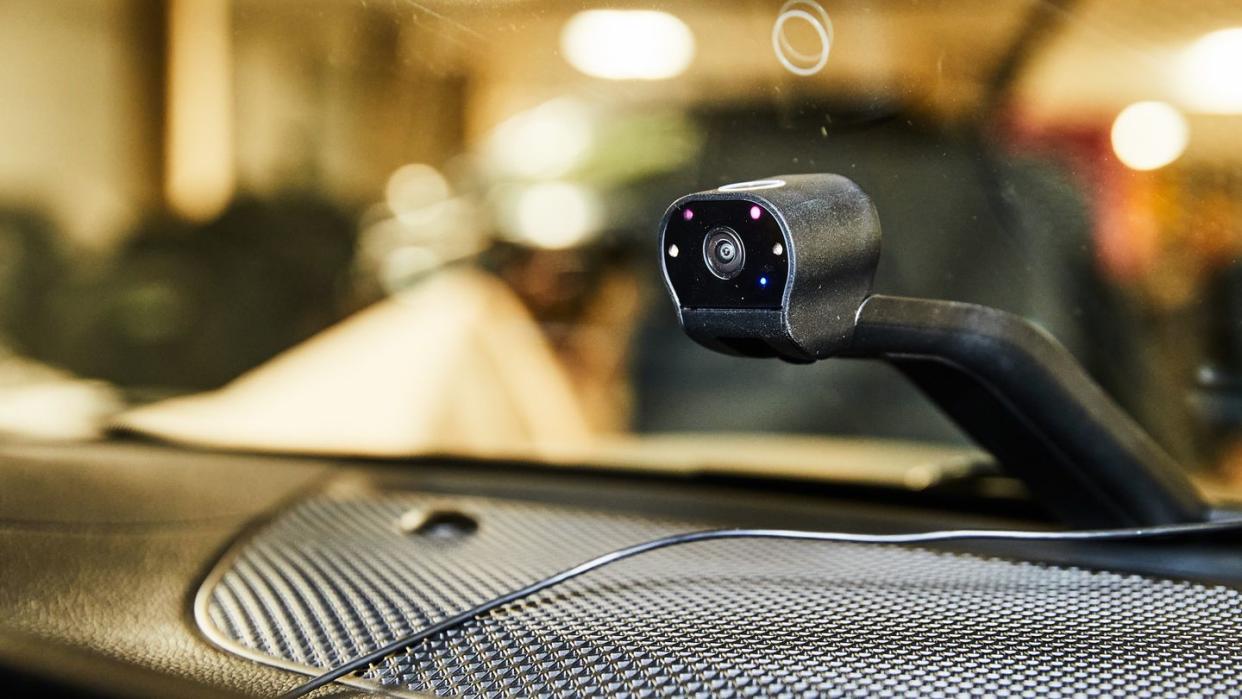
"Hearst Magazines and Yahoo may earn commission or revenue on some items through these links."
In driving and in life, a little preparation goes a long way. Installing a dash cam, which monitors the front (and often the interior) of your vehicle in the event of a theft or accident, is an easy and affordable way to protect yourself, your passengers, and your investment if calamity strikes.
In 2023, dash cams are smarter and better connected than ever. Many models offer security and quality-of-life features that extend beyond mere POV driving footage, offering driver-assist features like lane-change and forward collision warnings, impact detection and the ability to sync multiple cameras at once. There’s even an option that lets you check a cloud-enabled stream to check what’s happening in the car in real-time.
So whether you’re looking to add safety and accountability while your vehicle is in motion, give yourself peace of mind when it’s parked, or you simply want a camera to capture your next epic road trip, we’ve got a dash cam for you.
More Auto Gear: Best Car Accessories ● Best Car Emergency Kits ● Best Steering Wheel Covers
The Best Dash Cams
Best Overall: Nextbase 622GW Dash Cam
Best Value: 70mai A800S Dash Cam
Best for Easy Setup: Garmin Dash Cam 57
Best For Rideshare Drivers: Vantrue N4 Pro 3-Channel Dash Cam
Best For New Drivers: Garmin Dash Cam Live
The Expert (Dan Bracaglia): I’m a consumer technology journalist specializing in digital imaging. I’ve reviewed cameras of all shapes and sizes for Digital Photography Review, Best Products, and the Wall Street Journal, among others.
The Expert (Elvis Desai): Elvis Desai is a Senior Forensics Engineer at YA Engineering Services, specializing in automotive accident reconstruction. He works with dash cam footage and data to test vehicle safety. Desai holds a Master of Science in Automotive Systems Engineering with a specialty in Vehicle Safety from Kettering University.
The Expert (Edward J. Primeau): Ed Primeau is an audio and video forensics expert and the founder and co-owner of Primeau Forensics. He’s contributed commentary and analysis on forensic evidence from many high-profile investigations to news media organizations across the country. Of course, not all of Primeau’s work makes international news. He frequently reviews dash cam footage when investigating automobile accidents on behalf of insurance companies, police departments and other organizations.
What to Consider in a Dash Cam
Number of Cameras
The basic dash cam is designed to capture video from directly in front of a vehicle through the windshield. Increasingly, more advanced dash cams have two cameras–one to capture the road ahead and a second to simultaneously capture the cabin.
“These cameras are valuable for rideshare drivers and those concerned with capturing events inside the vehicle,” notes Primeau, “such as passenger behavior or interactions, which can be critical in certain accident scenarios.”
In addition, many dash cam models give you the ability to buy and sync up multiple units to shoot footage from your rear window or other perspectives. With a forward-facing camera in the front and a rear-facing camera in the back, you are more likely to get clear footage of important details like faces and license plates, even if the cabin camera isn’t in use.
Video Quality
The first thing you should check on any dash cam is its video resolution. With higher quality video, you can see more detail at a glance, which can be important when you only catch a crucial detail on camera for a moment.
Ideally, your dash cam should shoot in “4K Ultra High-Definition” (4K UHD). If you’re looking at budget-conscious models, look for “Quad High-Definition” (QHD), also known as 1440p. A 4K UHD video is made from four times as many pixels as the same thing shot in 1080p.
“When pixel information is sparse, it’s very difficult, if not impossible, to enhance a video to identify a vehicle or recover a license plate,” says Primeau.
Higher definition doesn’t automatically translate to better video quality, though, especially in challenging lighting conditions. All of the models we’ve included here offer a competent “night vision” mode, which enhances clarity in low light, when contrast is minimal.
You should also pay attention to your dash cam’s field of view, which indicates how much peripheral coverage it can capture. Ideally, you should look for a camera that covers a wide enough area to take in the full width of your windshield, but not so wide that the video looks distorted. Our experts recommend using a 140-155 degree field of view to achieve the best balance between coverage and picture quality.
Lastly, you’ll want to make sure your dash can capture audio in addition to video. While video is often most crucial in analyzing crash footage, audio can also be telling.
Storage
It’s important to understand how your dash cam stores the footage it records, and how you can transfer it to other devices for safekeeping. Most dash cams primarily rely on MicroSD cards to store footage locally. This will allow you to remove the card and transfer files whenever you need them.
Some dash cams will come with a small MicroSD card–16-32GB–but we always recommend springing for the largest MicroSD card your dash cam will accept. All dash cams feature “loop recording,” so they start to delete old video files when they run out of storage to ensure they can always record something important. By using the largest possible card, you decrease the possibility of accidentally losing an important video.
The difference between the default MicroSD card that may or may not come with your camera and the larger card you purchase on your own can be massive. The Nextbase 622GW, our top pick, can store up to 5.5 hours of 4K footage on a 128GB card before deleting older videos. A 256GB card, the largest capacity the Nextbase accepts, can hold up to 12 hours.
Keep in mind, though, that lower resolution video takes up less space. For example, Garmin Dash Mini 2 shoots in Full HD, so it can store up to 17 hours of footage using a 128GB card, and up to 33.8 hours using a 256GB SD.
In addition to local storage, some dash cams will back up all saved video files in the cloud. This saves you the trouble of needing to transfer your files from the camera to a computer. However, it’s worth noting that automatic cloud backups are usually part of a paid subscription from the manufacturer.
Garmin’s standard Vault subscription plan, for instance, saves all your videos to the cloud for up to seven days at a cost of $4.99 a month. Step up to the advanced plan for $9.99 a month and Garmin will hang on to your footage for 30 days.
Mount
Not all dash cam mounts are created equal. The best ones stick to the top of the windshield using either an adhesive mount or a suction cup. While some of the dash cams in our guide can be mounted on the dash itself, all are primarily meant to be affixed to your windshield near the rearview mirror.
Most adhesive mounts feature some sort of quick-release system to easily remove the camera, while leaving your mount in place. This makes it easy to remove your MicroSD card, which can be damaged by extreme heat and cold. We also prefer smaller mounts, which cover the windshield as little as possible, and tend to stay in place longer.
Screen
You don’t technically need a screen on a dash cam, but many folks find that it makes the device easier to set up and operate. You can also easily review footage on the fly, without having to pull out your phone and connect to a companion app. Experts like Desai recommend models with screens for more practical reasons, “You can see the icons and if it's recording properly.”
That said, don’t automatically dismiss a dash cam just because it doesn’t have a screen. Cams like the Garmin Dash Cam Mini 2 still provide great coverage, and have the advantage of being more discreet, meaning, they’re less likely to be spotted by thieves. Without a screen, though, dash cams live and die by their companion software.
Companion App
Most dash cams receive essential support from a smartphone companion app, which allows you to view video playback, adjust settings, and download saved footage. Finding an app that’s intuitive and easy to use can make or break your experience, and their quality can vary quite a bit from brand to brand.
Garmin’s Drive app, for instance, works reasonably well: Pairing a device is straightforward, navigating the app is intuitive enough, and most importantly, it's stable. Other apps, like those from Vantrue and 70mai, feature clunky controls and have trouble maintaining the connection between dash cam and phone.
You rarely need the app to capture footage and offload it onto a device using a MicroSD card, but you’ll miss out on a lot of functionality if you don’t use it.
Sensors
Mid-tier and high-end dash cams frequently have built-in GPS sensors to add location data to a video recording. This information can be vital after an accident has occurred.
“Capturing location data through GPS is crucial for providing context to dash cam footage. It helps establish the precise location of an incident, which is critical for accident reconstruction and legal purposes,” Primeau says. “Location data can corroborate or challenge eyewitness accounts and provide valuable insights into the sequence of events during an accident.
“Some models, like the Nextbase 622GW, can even beam your GPS location to emergency personnel if you’re incapacitated.
Budget dash cams tend to forgo GPS to cut down on costs. Some models, like the Garmin Mini 2, sidestep the issue by pulling data from your smartphone's GPS antenna. Of course, you’ll need to have your smartphone on you and paired to the device to make the most of this feature.
You should look for a dash cam with an onboard G-sensor, which allows your dash cam to detect any bumps or impacts to the car when you aren’t inside. Dash cams with this feature should be able to wake up and start recording when motion is detected, even when the car is off. Most manufacturers call this “parking mode.”
Power and Connectivity
Modern dash cams require continuous power to capture and store footage on the go, though many have small built-in batteries or capacitors that take over when an emergency occurs (like when an impact disables your car’s battery). Out-of-the-box, all of the dash cams in this guide can plug into a car’s standard 12-volt socket or a USB port.
If you want your dash cam to have power when no key is in the ignition, enabling “parking mode,” you’ll need to hook it up to your car’s battery power via an OBD-II port, which you can typically find under the dashboard on the driver’s side. It’s primarily used to access a car’s onboard computer when diagnosing mechanical problems, but can also be used to power a device.
Depending on the car and model, you may need to purchase an additional cable to connect the camera this way. On the plus side, it’s usually easy to install with a YouTube tutorial and a little elbow grease (unless you drive a Bugatti.) If you already have something slotted in the OBD-II, like an insurance tracker, you may want to look into getting a splitter.
Temperature Rating
If you plan to leave your dash cam in the car at all times, take a second to check the temperature rating or the manufacturer-quoted range in which it can safely be stored or operated.
The best models should work reliably when the temperature drops below freezing, or in extreme heat, up to 140 degrees Fahrenheit. Generally speaking, dash cam models that use a capacitor for backup power tend to be more stable at high temperatures than those with built-in battery backup. Unsurprisingly, they also tend to cost more.
How We Evaluated The Best Dash Dams
I selected the best dash cams based primarily on the insights and information I received from Desai and Primeau. I also spoke to several rideshare drivers to find out what dash cam features they rely on most.
Lastly, I checked expert reviews from leading automotive and technology publications, including Car & Driver, CNET, Tom’s Guide, and PCMag, as well as user reviews from several online retailers.
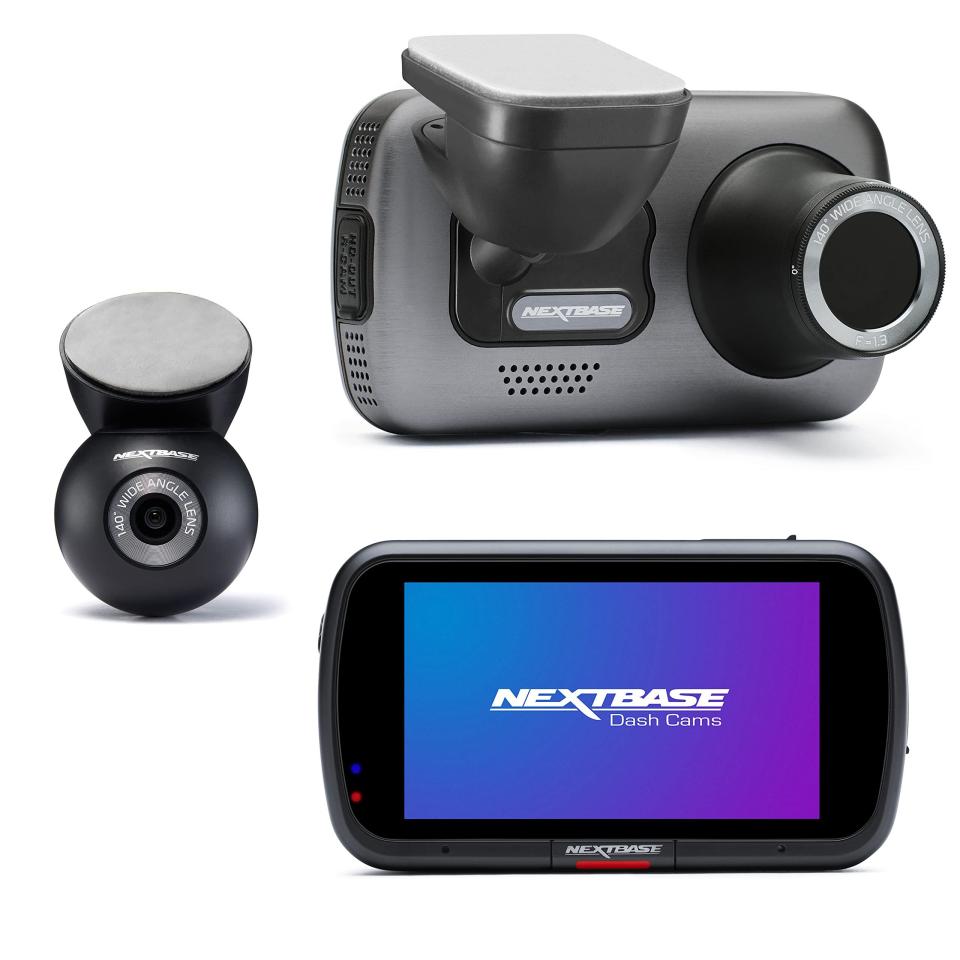
622GW Dash Cam
amazon.com
$499.98
The Nextbase 622GW checks all of the above boxes and then some. It captures in crisp 4K, producing detailed footage in both bright and low-light conditions, the latter of which comes courtesy of an impressive night vision mode. It also features a 3-inch touch screen, which has an intuitive interface.
This pick also opens the door for a wider range of complex setups. For not too much more cash ($100), you can add additional cameras to film the interior or out the back window of your vehicle. And, like most of the models here, installation of a relatively affordable ($30) accessory hardwire kit unlocks even more features, like the ability to monitor your car and begin capture when something occurs, even while you’re away.
In the event of an accident, the 622GW features SOS mode, which will call and send GPS coordinates to emergency personnel in the event of an accident, even if you’re unresponsive. It also features a built-in battery that can power the camera in the event the car battery is disabled. That battery has a tendency to fail in extreme heat, though, so you definitely don’t want to leave it baking in the hot Texas summer sun. That caveat aside, this is among the most well-rounded dash cams out there.

A800S Dash Cam
amazon.com
$139.99
For less than $150, the 70mai A800S captures clear 4K video, even in less-than-ideal lighting. It’s also fairly feature-packed for the price, with dual-channel support, built-in GPS, driver assist warnings, and more. You can easily review videos in the car or adjust all of these settings using its built-in 3-inch display. You can enable parking mode, though it requires a $20 hardwire kit.
The great price and solid features come with a few caveats, though. Users report that the 70mai companion app has both connectivity and UI issues on iOS and Android. It also struggles in sub-freezing temperatures, so make sure to take it out of your car during the winter. All that aside, the A800S offers a lot of functionality and high-resolution video for a very affordable price. That’s not too shabby.

Dash Cam 57
amazon.com
$229.99
The Garmin Dash Cam 57 has been on the market for a couple of years, but it still stands out as an appealing option for drivers who want a small and straightforward video capture setup. Recording in QHD (1440p), the footage isn’t quite as detailed as our top picks, but it delivers sharp daytime footage. Things get a little grainy at night and in inclement weather, but the quality should be usable in an emergency.
I personally love that, at 2.2- by 1.6- by 0.9-inches, the Dash Cam 57 is compact and discreet. Compared to the size of the device, the 2-inch display feels huge. I would’ve preferred a touch screen, but this unit has voice-activated controls that make it easy to adjust on the road. Plus, the 57 also plays nice with the Garmin Drive app, which is far more intuitive after a recent overhaul.
Even a simple dash cam should have some special features, though, right? The Dash Cam 57 features a host of driver assist notifications, like lane departure warnings, forward collision warnings, and “go” reminders. You also get parking mode, which will capture 15 seconds of footage if an impact with your vehicle is detected.
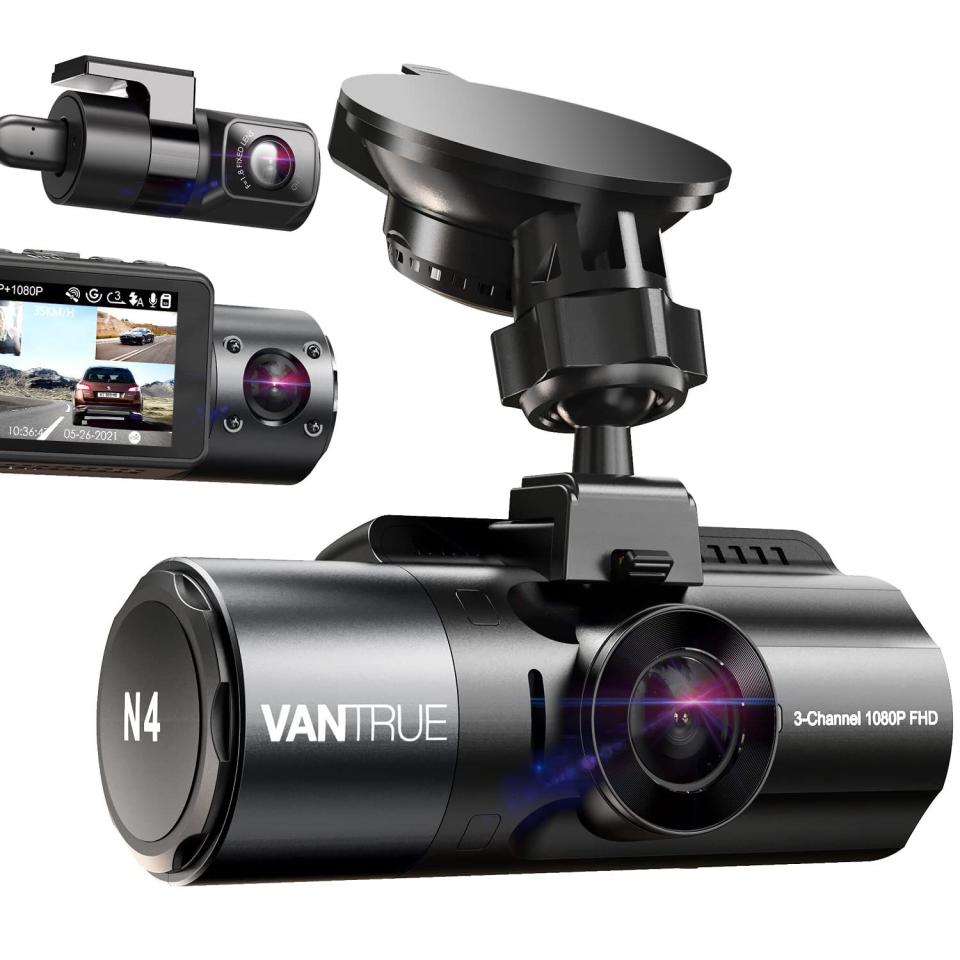
N4 Pro 3-Channel Dash Cam
amazon.com
$181.99
With three cameras to cover the front, back, and interior of your vehicle, the Vantrue N4 Pro is the perfect choice for rideshare drivers or anyone who wants full coverage of their vehicle while driving.
Its primary, front-facing camera captures in 4K resolution, while the two secondary cameras record in Full HD. While that isn’t ideal, the secondary cameras have features that cater to their specific uses: The interior-facing camera has an infrared mode that switches on in the dark. The rear camera supports high-dynamic range (HDR) processing to minimize blown-out lighting and grainy shadows. Both secondary cameras also have wider fields of view, allowing you to visualize the interior and behind your car.
You also get plenty of useful bells and whistles. The N4 Pro features voice control, GPS, a 3-inch display, and a functional, but slightly clunky companion app. It also supports parking mode with motion detection if you install the optional hardwire kit.
That said, this unit features an internal capacitor that allows it to record after an impact without a direct connection to power. With three cameras and so many useful features, the Vantrue N4 Pro keeps an eye on every part of your car, inside and out.
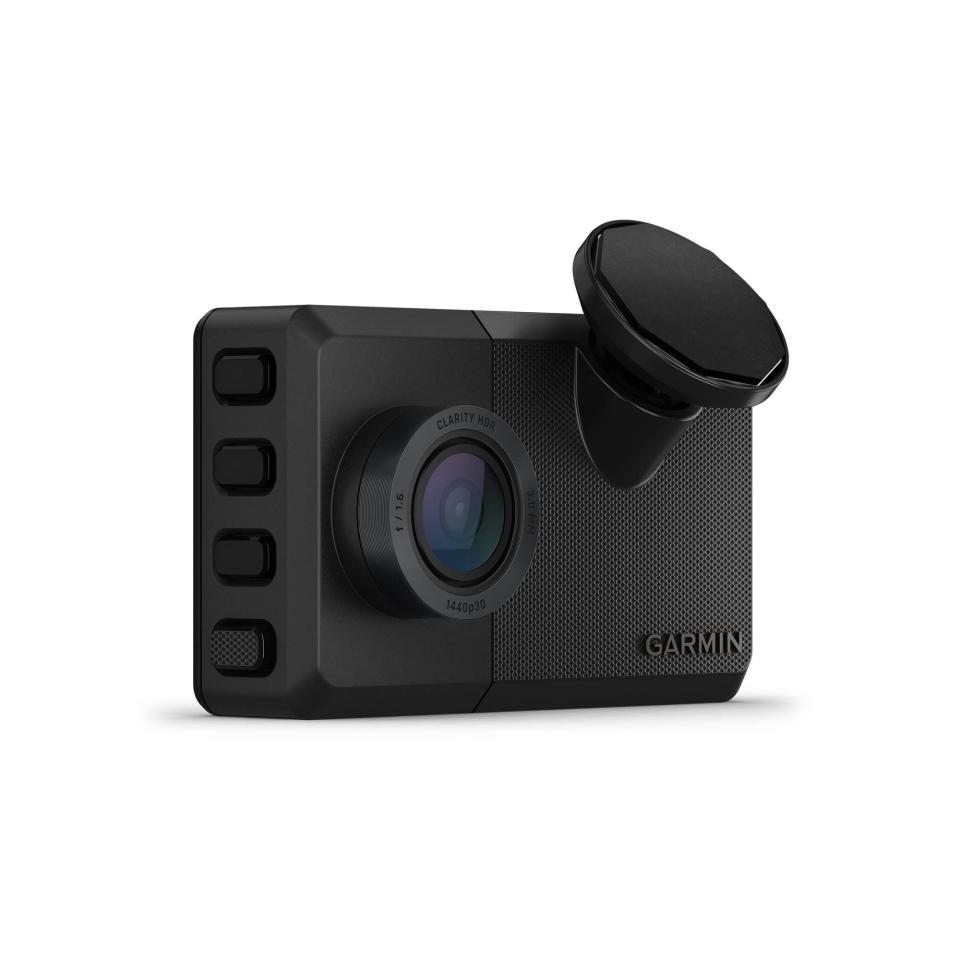
Dash Cam Live
amazon.com
$399.99
The new Garmin Dash Cam Live is one of the most feature-rich options out there, with the unique, tech-driven functionality to keep new drivers safe. Its signature highlight is the ability to watch what your camera is looking at at any time on your phone via livestream. That may give peace of mind to anxious parents who want to check on their kids during their first weeks on the road. It also allows you to track your car’s location via GPS, and get alerts if your car moves when your phone isn’t inside.
All of those outstanding features come with an annoying catch. Most of them are only enabled when you pay a monthly LTE subscription. The $9.99 subscription also backs up your recordings to the cloud, and enables additional notifications.
Beyond its smart features, the Dash Cam Live is a decent, fully-featured dash cam. The QHD camera works surprisingly well in daylight and decent in low light. It also offers a laundry list of useful features, including voice-activated controls and parking mode. We certainly understand if you balk at paying a monthly fee, but the Dash Cam Live delivers the kind of features that are worth a subscription.

Dash Mini 2
amazon.com
$129.99
Though it’s a bit older than the other options on this list, the Garmin Dash Cam Mini 2 remains the obvious choice for drivers who want a small, discreet dash cam. Thanks to its tiny 1.2- by 2.1- by 1.1-inch footprint and suction cup mount, you can set it and forget it in a flash. It’s also easy to move from vehicle to vehicle.
The small footprint obviously creates some limitations. At Full HD (1080p), it has the lowest resolution of any of our picks. It lacks a display, which may frustrate some users while adjusting settings. It also doesn’t have GPS support, which limits its functionality beyond basic recording.
The problems aren’t as bad as they sound, though. The video resolution is still clear in daylight and stays generally readable in low light. Though it doesn’t have any onboard controls, Garmin’s Drive app makes it easy to control settings with voice commands, review recordings, and handle storage transfers. (Like the other Garmin cams, you can also enable cloud backups with a Garmin Vault subscription.) This dash cam puts nearly everything we look for in a dash cam in the smallest possible package.

MAXcam 360c
amazon.com
$740.00
If you want a dash cam and a radar detector, Escort MAXcam 360c combines both functions into one effective device. A trusted brand in the radar detector space, the Escort MAXcam 360c can pick up all major police bands and alert you to laser detection. It doesn’t have the same functionality as the new and improved Escort MAXcam 360c Mk II, our favorite radar detector, but experts and users agree this is still one of the best options out there.
But what about video performance? The QHD camera performs well during the day, and reasonably well at night. Given that it’s a combo, the MAXcam 360c doesn’t have a luxurious feature set, but it has a G-sensor, so it will start capturing footage in the event an impact is detected.
That said, unlike other models in this guide, there’s no backup power source, so if a collision disables the car battery, you won’t be able to record. Still, this is a great option for folks who want to keep an eye out for speed traps as they record the road ahead.
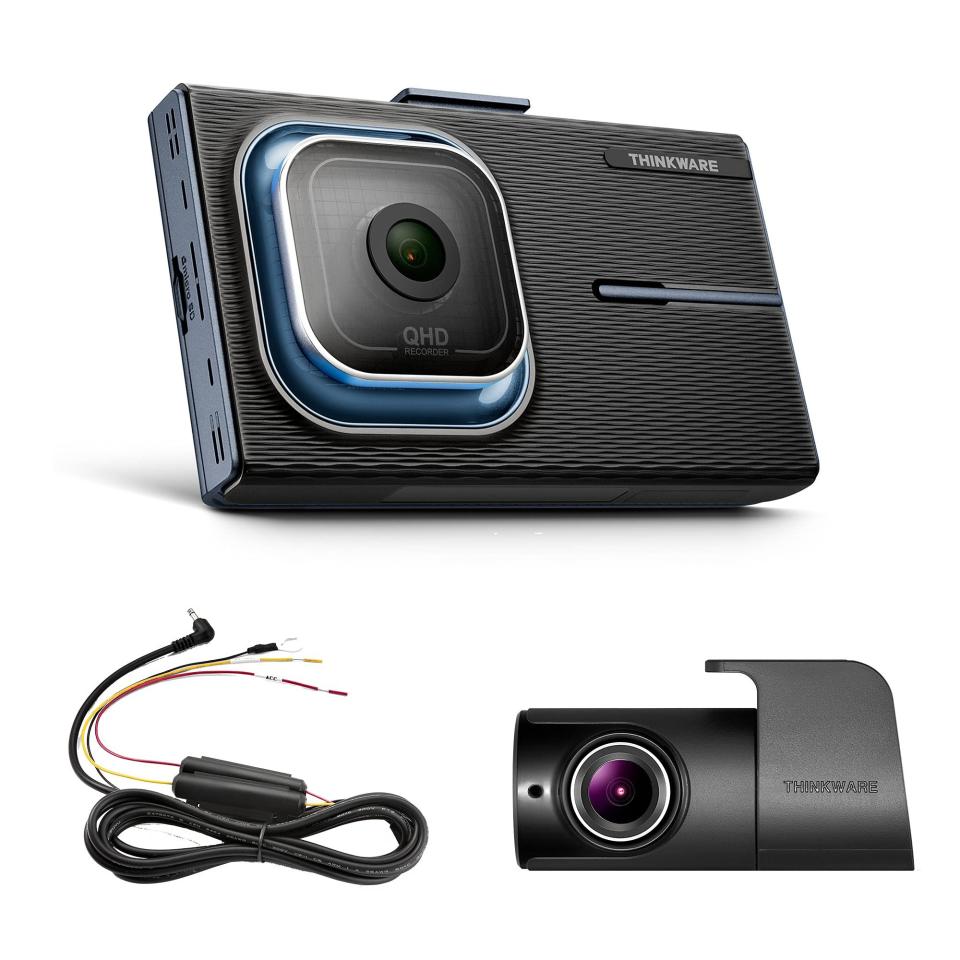
X1000 Front + Rear Dash Cam
amazon.com
$299.99
If you prefer not to connect your dash cam to your phone, the Thinkware X1000 is a robust, dual-sided dash cam with plenty of features, and is relatively easy to use without an app. It sports a large 3.5-inch touch display and a straightforward onboard user interface.
Both the front- and rear-facing cameras record in QHD, though they work surprisingly well in less-than-ideal driving conditions. The Thinkware X1000 also boasts an impressive temperature rating (thanks to a capacitor), parking mode, and an optional GPS accessory that unlocks a range of driver-assist features. It even comes with a 32GB MicroSD card to store and transfer your footage.
Unfortunately, this dash cam comes with one big caveat. You’ll need to wire the rear camera to your car’s electrical system, which requires either better-than-average automotive know-how or professional installation. Once it’s set up, though, the X1000 is easy to use.
Dash Cam Q+A With Our Experts
What’s The Best Place to Mount a Dash Cam?
According to Primeau, you should set your dash cam up directly behind your rearview mirror. “The goal is to get some of the vehicle hood recorded (unless you are driving a van) and as much of the road as possible.”
Primeau notes the importance of a high-quality mount, “Secure mounting is essential to prevent the camera from shifting or falling during sudden stops or collisions.”
Will Plugging My Dash Cam Into My Car’s OBD-II Port Drain The Vehicle Battery?
You don’t need to worry about it. If your car’s off, the dash cam should only switch on if an impact is detected, and record for just a short time. It shouldn’t use much power. Also, most modern car computers will cut power to the OBD-II port if the car battery’s charge gets too low.
Should I leave my dash cam in the car when parked or take it inside?
That depends. Do you live in a location with frequent vehicle break-ins? If so, it may not be the best idea to leave your dash cam unattended overnight. Like other electronics, a visible dash cam might attract car thieves, rather than deter them. After all, footage of a break-in isn’t all that useful if the camera and memory card are stolen.
That said, your dash cam’s parked car monitoring feature makes it useful to leave it up and running overnight, recording any car dings or dents your car while you’re parked. If you leave your dash cam in 24/7, make sure it's set up in an inconspicuous manner that doesn’t draw attention from passersby.
You Might Also Like

